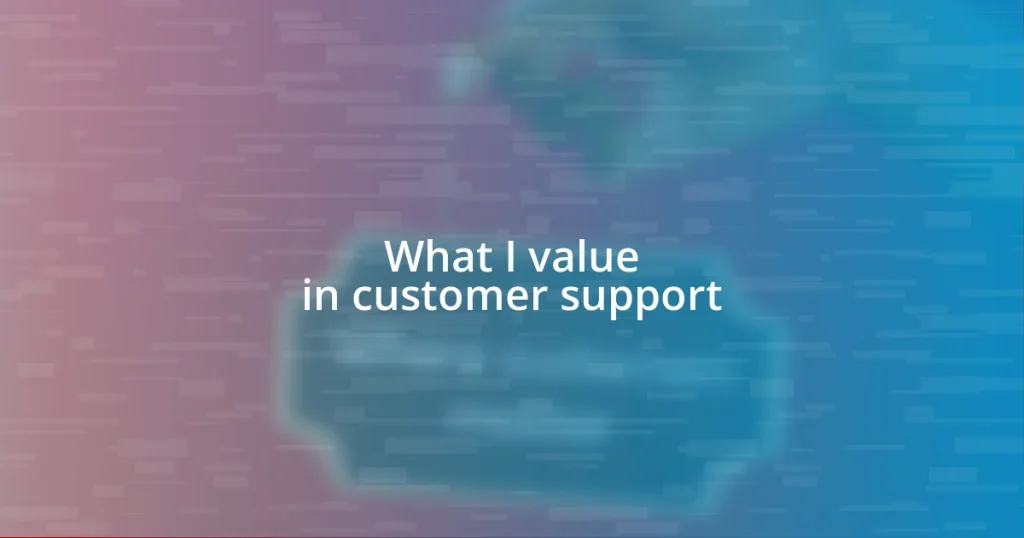Key takeaways:
- Identifying key competitors, both direct and indirect, offers valuable insights into the market landscape and can reveal hidden opportunities.
- Evaluating competitors’ products, including their unique selling propositions and customer feedback, can highlight gaps and inform enhancements to your offerings.
- Synthesizing competitive analysis findings into actionable strategies allows for better alignment with audience needs and identification of market trends.

Identify key competitors
Identifying key competitors is a foundational step in analyzing strategies effectively. I remember my first experience delving into competitor analysis; I was amazed at how many companies in my niche I initially overlooked. It’s essential to compile a comprehensive list of competitors, both direct and indirect, as this gives you a broader perspective on the market landscape.
As I sifted through various online resources and industry reports, I began to appreciate the nuances of competition. Have you ever considered how a seemingly unrelated company might influence your industry? I found that when I analyzed competitors from different angles—like their marketing tactics or customer engagement strategies—I discovered valuable insights that I could adapt to my own approach.
I often use tools like SEMrush and SimilarWeb to gather data, but I also rely on gut feeling and instinct. Sometimes, my intuition leads me to a competitor I hadn’t initially thought of. I believe it’s crucial to challenge your own assumptions; by doing so, you may uncover hidden threats or opportunities that could redefine your strategy.

Evaluate competing products
When evaluating competing products, I often start by examining their unique selling propositions (USPs). This analysis reveals what makes each product stand out in a crowded market, and it’s fascinating to see how different brands position themselves. In my first real competitor dive, I was struck by how one brand’s eco-friendly packaging appealed to a customer segment that I hadn’t considered before. It opened my eyes to the importance of values in consumer choices.
Next, I take a closer look at customer reviews and feedback. These insights can be goldmines for understanding what consumers appreciate or dislike about competing products. I remember scanning through reviews for a budget-friendly alternative in my niche and found that customers valued durability over price, an insight I intended to incorporate in my offerings. That moment reinforced for me how crucial it is to listen to the voice of the customer.
Lastly, I find it helpful to compare features, pricing, and availability side by side. This comparison often highlights gaps in my product that I can address. In one instance, during a detailed comparison of software tools, I realized that my competitor offered an advanced feature set at a competitive price, which made me rethink my pricing strategy. It’s an ongoing process that keeps me agile and informed.
| Product Name | Unique Selling Proposition |
|---|---|
| Competitor A | Eco-friendly materials |
| Competitor B | Budget-friendly pricing |
| Competitor C | Advanced features |

Analyze competitor marketing tactics
Analyzing competitor marketing tactics requires a deep dive into their online presence and engagement strategies. I vividly remember a time when I stumbled upon a competitor’s social media campaign that was performing exceptionally well. They utilized storytelling in their posts, connecting emotionally with their audience, which prompted me to rethink my own content strategy. By closely observing their approach, I realized the importance of creating narratives that resonate with potential customers, prompting me to experiment with this method in my marketing efforts.
To effectively analyze these tactics, I often look at the following key points:
- Social Media Platforms: Identify which platforms they prioritize and how they engage their audience.
- Content Types: Take note of the formats they prefer, such as videos, infographics, or blog posts, and how frequently they post.
- Call-to-Actions: Observe the language and strategies they use to drive engagement and conversions.
- Email Campaigns: Analyzing their newsletter design and content helps to uncover their approach to building customer loyalty.
- Promotions and Discounts: I pay attention to the promotions they’re running and the messaging behind them to gauge their market positioning.
Each insight gained from this analysis not only enhances my understanding of the competitive landscape but also sparks creativity in my marketing initiatives, often leading to unexpected breakthroughs.

Assess their online presence
To assess their online presence effectively, I usually start with a thorough examination of their website. I can’t stress how telling the design and usability can be; a polished, user-friendly site communicates professionalism and encourages visitors to explore further. I remember a competitor who revamped their website with vibrant visuals and clear navigation, which not only increased their engagement rates but also left a lasting impression on me about the power of first impressions.
Social media channels are another vital aspect of their online presence. I take note of how often they post and the type of content they share. For instance, I once noticed a competitor regularly interacting with their followers through Q&A sessions and live updates. This engagement felt authentic, making their brand relatable. It got me thinking: how am I engaging my audience? Sometimes, I find myself inspired by their approach, prompting me to enhance my interaction strategies.
Additionally, I pay close attention to their search engine optimization (SEO) tactics and online visibility. Analyzing keywords they target reveals a lot about their marketing focus. During my research, I discovered a competitor effectively using long-tail keywords, which helped them rank higher in search results. This insight reshaped my SEO strategy, reminding me of the importance of being precise and intentional in online content. Have you ever considered how small changes can make a significant difference in visibility? It’s moments like these that keep me motivated to iterate and adapt.

Monitor social media engagement
Monitoring social media engagement is about more than just looking at numbers; it’s about understanding the stories behind those metrics. I remember coming across a competitor’s post that generated an unexpected amount of comments, sparking an intriguing discussion among followers. This taught me the power of creating content that not only informs but also invites conversation. Have you ever thought about how a simple question at the end of a post can catalyze engagement? I certainly didn’t until that moment.
One thing I consistently track is the sentiment of comments on my competitors’ posts. I once noticed a brand facing backlash over a poorly received promotion. This was a real eye-opener for me, emphasizing the importance of aligning the brand message with audience expectations. It made me reflect on my own promotional tactics and how crucial it is to anticipate how customers might react. How often do you analyze the reactions to your competitors’ posts? I find that assessing both positive and negative feedback can inform my strategy for approaching similar situations.
I also pay attention to the times of day when competitors post. After analyzing one rival’s activity, I discovered that their highest engagement often occurred during the evenings. This prompted me to shift my posting schedule and experiment with timing. I think it’s fascinating to consider how an adjustment in when we share content can completely change our audience’s interaction with it. Have you ever played around with posting times? It’s rewarding to see how small tweaks can lead to greater visibility and engagement.

Review customer feedback and reviews
Reviewing customer feedback and reviews is a crucial step in my competitive analysis process. I often dive into online platforms where customers share their thoughts—places like Google Reviews and Yelp provide honest perspectives that are hard to overlook. I recall a moment when I discovered a competitor receiving consistent praise for their customer service. This insight not only made me rethink my service approach but also spurred improvements in how my team interacts with our clients. Have you ever considered how customer feedback can directly shape your business strategies?
I also pay attention to the specific language customers use when describing their experiences. For example, during one analysis, I noticed a competitor often described as “responsive” and “attentive.” It struck me that these particular adjectives created a strong emotional response. This insight made me realize that by fostering a similar perception, I could enhance my own brand’s image. What words do customers use to describe your competitors? I find that these nuances can guide not just marketing efforts, but also service training.
Additionally, I look for patterns in negative reviews. These can reveal significant gaps in competitors’ strategies. I remember reading a series of complaints about long wait times for customer support from one rival. That feedback highlighted an opportunity for them—and for me to avoid the same pitfall. Have you ever thought about how analyzing your competitor’s weaknesses could give you a competitive edge? I often find that transforming a flaw into a strength can be my secret weapon in winning over customers.

Synthesize findings for strategy
Syndicating my findings is where the magic happens for my strategy. I find it essential to take a step back and see the bigger picture after I’ve gathered all that competitive intel. For instance, during one analysis, I started noticing that many of my competitors emphasized quality over price in their marketing. This realization prompted me to reevaluate my own messaging, and I began highlighting the exceptional quality of my products. It’s amazing how seeing trends can shift your focus; have you ever restructured your strategy because of findings like these?
I also like to create a competitive strengths and weaknesses matrix. This exercise has proven invaluable over the years. I remember developing one for a particular campaign where my main rival was crushing it with a sleek visual identity. It dawned on me that while I had a strong narrative, I was lacking in visual impact. By synthesizing this information, I not only pinpointed the gaps but also identified opportunities to elevate my own visuals. Have you ever considered how a simple chart can crystallize your thoughts and lead to actionable steps?
Moreover, synthesizing findings into actionable insights often pushes me to consider audience alignment. After reviewing various brands, I reflected on their target markets and recognized a distinctly underserved demographic in my niche. This was a pivotal moment for me, pushing my offerings to cater to those overlooked voices. Have you felt that urge to pivot your initiative based on what competitors miss? It just drives home the idea that synthesizing isn’t just about numbers and trends; it’s about connecting the dots in a way that resonates with the needs of your audience.














